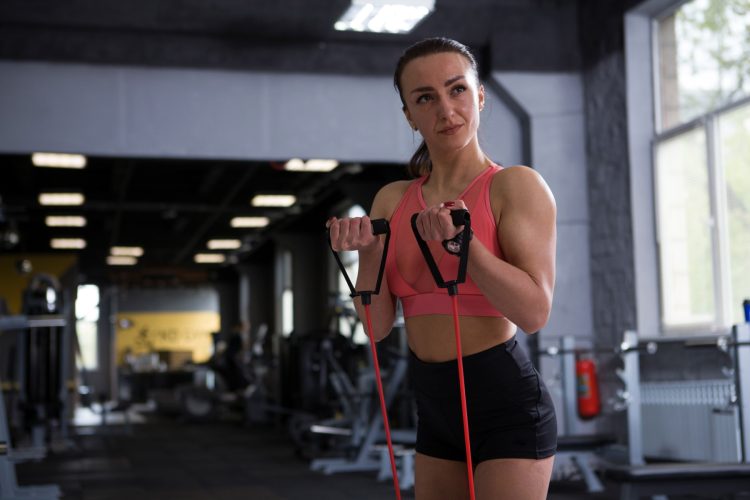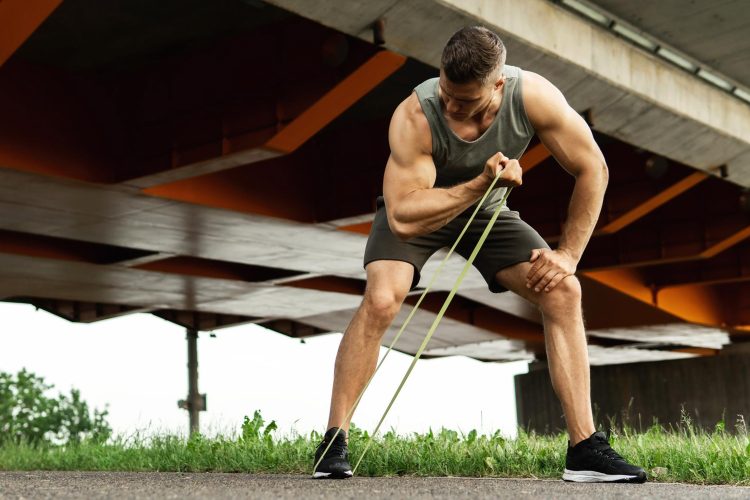Most exercisers have radical opinions about resistance bands. While some love it, others think they are a complete waste of time.
The truth is, when used correctly, resistance bands can be as effective as dumbbells and barbells at promoting hypertrophy.
A systematic review and meta-analysis in the Sage Open Medicine journal concluded that resistance band training can promote similar strength gains to conventional resistance training methods (dumbbells and weight machines) in different population profiles and using diverse protocols. (1)
Resistance bands are especially great for training the arms and are a godsend for people who train at home or for folks who spend a considerable amount of time traveling.
In this article, I will give you a 12-minute workout to help you build sleeve-ripping pythons that you can do in the comfort of your living room.
The 12-Minute Resistance Band Arm Workout
Level Up Your Fitness: Join our 💪 strong community in Fitness Volt Newsletter. Get daily inspiration, expert-backed workouts, nutrition tips, the latest in strength sports, and the support you need to reach your goals. Subscribe for free!
Follow the workout given below to add inches to your arms:
| Phase | Exercise | Time | Beginner Variation | Intermediate Variation | Advanced Variation |
| Warm-Up | Light Cardio or Dynamic Stretches | 3 minutes | – | – | – |
| Circuit | Banded Bicep Curl | 1-minute | Light band, 10-12 reps | Medium band, 12-15 reps | Heavy band, 15-20 reps |
| Banded Tricep Extension | 1-minute | Light band, 10-12 reps | Medium band, 12-15 reps | Heavy band, slow eccentric (lowering) phase | |
| Banded Hammer Curl | 1-minute (30 seconds each side) | Light band, 10-12 reps | Medium band, 12-15 reps | Heavy band, 15-20 reps | |
| Banded Close-Grip Push-Up | 1-minute | Light band, 10-12 reps | Medium band, 12-15 reps | Heavy band, hold at the top for 2 seconds | |
| Banded Concentration Curl | 1-minute (30 seconds each side) | Light band, 10-12 reps | Medium band, 12-15 reps | Heavy band, 15-20 reps | |
| Banded Tricep Kickback | 1-minute (30 seconds each side) | Light band, 10-12 reps | Medium band, 12-15 reps | Heavy band, 15-20 reps | |
| Cool Down | Static Stretches | 3 minutes | – | – | – |
Warm-Up
Begin the workout with a three-minute warm-up to loosen your muscles, tendons, joints, and ligaments. The warm-up session could be low-intensity steady state (LISS) cardio or dynamic stretches like arm circles, arm swings, overhead stretches, and shoulder rolls.
Workout
This is a circuit training session, which involves low-to-no rest duration between exercises. For instance, after you are done performing a one-minute set of banded biceps curls, you will directly move to the tricep extensions.
Each exercise has a time-based target. For instance, beginners must perform 10-12 reps of the banded bicep curl. However, if you can complete the recommended number of repetitions before the one-minute mark, you can use the remaining time to rest.
Beginners should use a lighter band and aim for 10-12 reps, intermediate lifters can opt for a moderate band and perform 12-15 reps, and advanced exercisers should employ the heaviest possible band for 15-20 reps.
Pro Tip: Increase the number of reps per exercise for the given duration as you gain more experience.
That said, make sure you’re not compromising your form trying to perform the recommended number of repetitions. Use the rest-pause technique if you struggle to complete the reps using a picture-perfect form.
Beginners should hire a personal trainer to learn the correct movement mechanics and maximize their training performance.
Cool Down
Conclude the workout with a three-minute static stretching routine to flush the lactic acid and other metabolites out of the working muscles and kickstart the recovery process.
Why Use Resistance Bands To Train Arms
As a veteran person trainer with over seven years of hands-on experience, I absolutely adore resistance bands. While most people join the gym to get their hands on dumbbells, barbells, cables, and machines, I have my personal training clients start with resistance band exercises.
Here are the benefits of adding resistance band exercises to your regime:
Beginner Accessible
Dumbbells are great, but lugging them around can be a hassle. Plus, most beginners find it challenging to develop a mind-muscle connection while training their guns using dumbbells. Resistance bands fix this issue.
Modifiable tube resistance bands offer varying resistance to ensure you’re progressively overloading the target muscles to ensure consistent gains.
Budget-Friendly.
Buying a full set of dumbbells for your home gym can burn a hole in your wallet. Resistance bands, however, are more affordable and deliver nasty muscle pumps each time. A complete set of resistance bands usually cost less than a single 15-pound dumbbell.
Versatility
Resistance bands are a versatile training tool that can be used by lifters of all experience levels to train every muscle group. You are limited by your own imagination when it comes to what you can train with a resistance band.
“Make sure you get multiple bands with varied resistances,” said fitness and wellbeing coach Rachel Lines. “Lighter bands are good for warming up, mobility, or rehab exercises, like rotator cuff exercises, while heavier resistance bands are great for back and leg workouts.”
Get Fitter, FasterLevel Up Your Fitness: Join our 💪 strong community in Fitness Volt Newsletter. Get daily inspiration, expert-backed workouts, nutrition tips, the latest in strength sports, and the support you need to reach your goals. Subscribe for free!
Variable (But Constant) Tension
Resistance bands keep constant tension on the target muscles throughout the range of motion. Plus, as you perform a banded tricep extension with a resistance band, you are stretching the band, which increases the tension on your tricep.
On the other hand, you must control the bands’ attempt to recoil on the eccentric (muscle lengthening) phase.
“Resistance upon a muscle can be done in many ways, and resistance bands are a great way to do it,” said Seamus Sullivan, a certified strength and conditioning coach. “The resistance curve is the biggest difference between bands and free weights. For instance, dumbbells will place the same amount of weight on the target muscle throughout a range of motion. However, with a band, it gets more challenging as you stretch it more.”
Joint Safety
In my experience, most people don’t use momentum while performing resistance band exercises, which can significantly lower strain on the joints, tendons, and ligaments.
A meta-analysis of 13 randomized controlled trials found that resistance band training over 12 weeks in older adults significantly improved muscle strength, body composition, and physical function tasks while keeping joint strain to a minimum. (2)
Travel-Sized
Resistance bands are compact and lightweight compared to dumbbells, which makes them perfect to carry with you while traveling. I also recommend carrying a pair of resistance bands in your gym bag to the gym to use on machines like leg curls, Smith machine, leg curls, and machine preacher curls.
How Resistance Bands Can Be Used to Target Arm Muscles Effectively
Contrary to what most people think, resistance bands are not just for warm-ups or light exercises. Here is how you can use bands to take your workouts to the next level:
Tension is Key
Dumbbells and barbells rely on gravity for resistance, meaning there is less resistance at the bottom and top of the range of motion (ROM) in exercises like the bicep curls. However, this is not the case with resistance bands.
The tension mounts consistently as you pull on the resistance band. There is tension on the band at the top and bottom of the range of motion. However, you must ensure the band is taut in the starting position.
Unstable Resistance
Single-arm resistance band bicep exercises are inherently unstable and force your stabilizer muscles into action. The constant tension in the unstable bicep curl setup will recruit your abs, forearms, triceps, and shoulders.
Angle Variety
Resistance bands are incredibly versatile. You can attach one end of the resistance band to a sturdy object and shift your body position to change the band’s angle and train your muscles from different angles.
For example, tie one end of a resistance band to an object in line with your left foot, hold the other end with your right hand, and perform bicep curls to target the outer bicep head and develop a bigger peak. Conversely, a wider angle will hit the inner bicep head.
Resistance Band Modifications to Maximize Results
Use the following tips and techniques to get the best bang for your buck from your resistance band arm workouts:
Change Your Angles
Have you been performing resistance band bicep curls with one end of the band wrapped around your feet and the other around your hands?
Change the line of pull by tying the bottom end of the band to the base of a sturdy pole two to three feet in front of you. This small tweak will fire up different muscle fibers in your arms, sparking new growth.
Switch Your Grip
Switch between a narrow, wide, and shoulder-width grip to train the target muscle fibers from different angles. You could also alternate between a pronated, supinated, and neutral grip to bias different muscles.
Tweak the Rep Tempo
As you gain more experience, you should slow down the eccentric (muscle lengthening) phase to increase the time under tension (TUT) and promote hypertrophy and strength gains (3). I recommend a 3:1:1:1 tempo for most exercises. It involves three seconds on the eccentric phase and one second each in the bottom position, on concentrics, and at the top.
Stack Multiple Bands
Sticking to the same exercises and training volume for an extended period can lead to strength and muscle plateaus. Grab a heavier band or layer two or three bands to challenge your muscles and avoid hitting the overhead ceiling.
Programming the 12-Minute Resistance Band Arm Workout
Maximize the results with these banded arm workout programming tips:
- Frequency: Since this is a low-volume arm workout that takes only a few minutes, frequent sessions are what you need. Perform this workout at least twice weekly to maximize gains, especially if you only perform resistance bands or bodyweight workouts.
- Nutrition and Rest: You cannot out-train a bad diet. Eat a balanced diet and hit your daily micro and macronutrient goals to boost your recovery — and growth.
- Tracking: Use multiple measurement metrics like a weighing scale, body measurements, and progress pics to track your progress.
Conclusion
You don’t necessarily need dumbbells to build bigger and stronger arms. Resistance bands keep constant tension on the target muscles throughout the ROM and increase the difficulty in the concentric phase, leading to greater peak contraction.
Follow the 12-minute resistance band arm workout detailed in this article to build the guns you’ve already wanted.
If you have any questions about training arms using resistance bands, drop them in the comments below, and I’ll be happy to help!
References
- Lopes JSS, Machado AF, Micheletti JK, de Almeida AC, Cavina AP, Pastre CM. Effects of training with elastic resistance versus conventional resistance on muscular strength: A systematic review and meta-analysis [published correction appears in SAGE Open Med. 2020 Sep 9;8:2050312120961220]. SAGE Open Med. 2019;7:2050312119831116. Published 2019 Feb 19. doi:10.1177/2050312119831116
- Zhao H, Cheng R, Song G, et al. The Effect of Resistance Training on the Rehabilitation of Elderly Patients with Sarcopenia: A Meta-Analysis. Int J Environ Res Public Health. 2022;19(23):15491. Published 2022 Nov 22. doi:10.3390/ijerph192315491
- Azevedo PHSM, Oliveira MGD, Schoenfeld BJ. Effect of different eccentric tempos on hypertrophy and strength of the lower limbs. Biol Sport. 2022;39(2):443-449. doi:10.5114/biolsport.2022.105335











